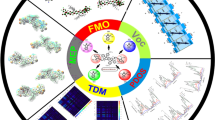Abstract
Despite much progress in organic solar cells (OSCs), higher efficiency is still the most desirable goal and can indeed be obtained through rational design of active layer materials and device optimization according to the theoretical prediction. Herein, under the guidance of a semi-empirical model, two new non-fullerene small molecule acceptors (NF-SMAs) with an acceptor-donor-acceptor (A-D-A) architecture, namely, 6T-OFIC and 5T-OFIC, have been designed and synthesized. 6T-OFIC exhibits wider absorption spectrum and a red-shifted absorption onset (λonset) of 946 nm due to its extended conjugation central unit. In contrast, 5T-OFIC with five-thiophene-fused backbone has an absorption with the λonset of 927 nm, which is closer to the predicted absorption range for the best single junction cells based on the semi-empirical model. Consequently, the device based on 5T-OFIC yields a higher power conversion efficiency (PCE) of 13.43% compared with 12.35% of the 6T-OFIC-based device. Furthermore, an impressive PCE of 15.45% was achieved for the 5T-OFIC-based device when using F-2Cl as the third component. 5T-OFIC offers one of a few acceptor cases with efficiencies over 15% other than Y6 derivatives.
摘要
本工作中, 在我们发展的半经验模型的指导下, 设计合成了两个A-D-A骨架受体分子, 6T-OFIC和5T-OFIC. 因其较长的共轭骨架, 6T-OFIC的截止吸收波长为946 nm. 相比于6T-OFIC, 因其骨架少一个噻吩单元, 5T-OFIC分子的截止吸收波长为927 nm, 更接近半经验模型所预测的最佳单结器件的截止吸收波长. 最终, 基于PM6:5T-OFIC的器件获得了13.43%的能量转换效率, 高于PM6:6T-OFIC器件. 以F-2Cl作为第三组份, 基于PM6:F-2Cl:5TOFIC的三元器件其填充和开压得到了明显的提高, 最终获得了15.45%的能量转换效率.
Similar content being viewed by others
References
Kim JY, Lee K, Coates NE, et al. Efficient tandem polymer solar cells fabricated by all-solution processing. Science, 2007, 317: 222–225
You J, Dou L, Yoshimura K, et al. A polymer tandem solar cell with 10.6% power conversion efficiency. Nat Commun, 2013, 4: 1446
Kan B, Li M, Zhang Q, et al. A series of simple oligomer-like small molecules based on oligothiophenes for solution-processed solar cells with high efficiency. J Am Chem Soc, 2015, 137: 3886–3893
Deng D, Zhang Y, Zhang J, et al. Fluorination-enabled optimal morphology leads to over 11% efficiency for inverted small-molecule organic solar cells. Nat Commun, 2016, 7: 13740
Xiao Z, Jia X, Ding L. Ternary organic solar cells offer 14% power conversion efficiency. Sci Bull, 2017, 62: 1562–1564
Bin H, Yang Y, Zhang ZG, et al. 9.73% efficiency nonfullerene all organic small molecule solar cells with absorption-complementary donor and acceptor. J Am Chem Soc, 2017, 139: 5085–5094
Chen Y, Wan X, Long G. High performance photovoltaic applications using solution-processed small molecules. Acc Chem Res, 2013, 46: 2645–2655
Hou J, Inganäs O, Friend RH, et al. Organic solar cells based on non-fullerene acceptors. Nat Mater, 2018, 17: 119–128
Cheng P, Li G, Zhan X, et al. Next-generation organic photovoltaics based on non-fullerene acceptors. Nat Photon, 2018, 12: 131–142
Meng L, Zhang Y, Wan X, et al. Organic and solution-processed tandem solar cells with 17.3% efficiency. Science, 2018, 361: 1094–1098
Yuan J, Zhang Y, Zhou L, et al. Single-junction organic solar cell with over 15% efficiency using fused-ring acceptor with electron-deficient core. Joule, 2019, 3: 1140–1151
Liu Q, Jiang Y, Jin K, et al. 18% efficiency organic solar cells. Sci Bull, 2020, 65: 272–275
Zhou Z, Xu S, Song J, et al. High-efficiency small-molecule ternary solar cells with a hierarchical morphology enabled by synergizing fullerene and non-fullerene acceptors. Nat Energy, 2018, 3: 952–959
Zhang G, Zhao J, Chow PCY, et al. Nonfullerene acceptor molecules for bulk heterojunction organic solar cells. Chem Rev, 2018, 118: 3447–3507
Wan X, Li C, Zhang M, et al. Acceptor-donor-acceptor type molecules for high performance organic photovoltaics-chemistry and mechanism. Chem Soc Rev, 2020, 49: 2828–2842
Sun H, Song X, Xie J, et al. PDI derivative through fine-tuning the molecular structure for fullerene-free organic solar cells. ACS Appl Mater Interfaces, 2017, 9: 29924–29931
Chen W, Zhang Q. Recent progress in non-fullerene small molecule acceptors in organic solar cells (OSCs). J Mater Chem C, 2017, 5: 1275–1302
Li G, Chang WH, Yang Y. Low-bandgap conjugated polymers enabling solution-processable tandem solar cells. Nat Rev Mater, 2017, 2: 17043
Sun Y, Chang M, Meng L, et al. Flexible organic photovoltaics based on water-processed silver nanowire electrodes. Nat Electron, 2019, 2: 513–520
Sun R, Wu Q, Guo J, et al. A layer-by-layer architecture for printable organic solar cells overcoming the scaling lag of module efficiency. Joule, 2020, 4: 407–419
Liu S, Yuan J, Deng W, et al. High-efficiency organic solar cells with low non-radiative recombination loss and low energetic disorder. Nat Photonics, 2020, 14: 300–305
Jiang K, Wei Q, Lai JYL, et al. Alkyl chain tuning of small molecule acceptors for efficient organic solar cells. Joule, 2019, 3: 3020–3033
Sun C, Qin S, Wang R, et al. High efficiency polymer solar cells with efficient hole transfer at zero highest occupied molecular orbital offset between methylated polymer donor and brominated acceptor. J Am Chem Soc, 2020, 142: 1465–1474
Lin Y, Adilbekova B, Firdaus Y, et al. 17% efficient organic solar cells based on liquid exfoliated WS2 as a replacement for PEDOT: PSS. Adv Mater, 2019, 31: 1902965
Chao P, Chen H, Zhu Y, et al. A benzo[1,2-b:4,5-c′]dithiophene-4,8-dione-based polymer donor achieving an efficiency over 16%. Adv Mater, 2020, 32: 1907059
Zhou Z, Liu W, Zhou G, et al. Subtle molecular tailoring induces significant morphology optimization enabling over 16% efficiency organic solar cells with efficient charge generation. Adv Mater, 2019, 32: 1906324
Yan T, Song W, Huang J, et al. 16.67% rigid and 14.06% flexible organic solar cells enabled by ternary heterojunction strategy. Adv Mater, 2019, 31: 1902210
Li K, Wu Y, Tang Y, et al. Ternary blended fullerene-free polymer solar cells with 16.5% efficiency enabled with a higher-LUMO-level acceptor to improve film morphology. Adv Energy Mater, 2019, 9: 1901728
Sun H, Liu T, Yu J, et al. A monothiophene unit incorporating both fluoro and ester substitution enabling high-performance donor polymers for non-fullerene solar cells with 16.4% efficiency. Energy Environ Sci, 2019, 12: 3328–3337
Gao J, Wang J, An Q, et al. Over 16.7% efficiency of ternary organic photovoltaics by employing extra PC71BM as morphology regulator. Sci China Chem, 2019, 63: 83–91
Cui Y, Yao H, Zhang J, et al. Over 16% efficiency organic photovoltaic cells enabled by a chlorinated acceptor with increased open-circuit voltages. Nat Commun, 2019, 10: 2515
An Q, Wang J, Gao W, et al. Alloy-like ternary polymer solar cells with over 17.2% efficiency. Sci Bull, 2020, 65: 538–545
Luo Z, Sun R, Zhong C, et al. Altering alkyl-chains branching positions for boosting the performance of small-molecule acceptors for highly efficient nonfullerene organic solar cells. Sci China Chem, 2020, 63: 361–369
Ke X, Meng L, Wan X, et al. The rational and effective design of nonfullerene acceptors guided by a semi-empirical model for an organic solar cell with an efficiency over 15%. J Mater Chem A, 2020, 8: 9726–9732
Gao HH, Sun Y, Wan X, et al. Design and synthesis of low band gap non-fullerene acceptors for organic solar cells with impressively high jsc over 21 mA cm−2. Sci China Mater, 2017, 60: 819–828
Gao HH, Sun Y, Cai Y, et al. Achieving both enhanced voltage and current through fine-tuning molecular backbone and morphology control in organic solar cells. Adv Energy Mater, 2019, 9: 1901024
Zhang M, Guo X, Ma W, et al. A large-bandgap conjugated polymer for versatile photovoltaic applications with high performance. Adv Mater, 2015, 27: 4655–4660
Blom P, Mihailetchi V, Koster L, et al. Device physics of polymer: Fullerene bulk heterojunction solar cells. Adv Mater, 2007, 19: 1551–1566
Huang Y, Kramer EJ, Heeger AJ, et al. Bulk heterojunction solar cells: Morphology and performance relationships. Chem Rev, 2014, 114: 7006–7043
Liu T, Zhang Y, Shao Y, et al. Asymmetric acceptors with fluorine and chlorine substitution for organic solar cells toward 16.83% efficiency. Adv Funct Mater, 2020, 30: 2000456
Zhang Y, Feng H, Meng L, et al. High performance thick-film nonfullerene organic solar cells with efficiency over 10% and active layer thickness of 600 nm. Adv Energy Mater, 2019, 9: 1902688
Lu L, Kelly MA, You W, et al. Status and prospects for ternary organic photovoltaics. Nat Photon, 2015, 9: 491–500
Gasparini N, Jiao X, Heumueller T, et al. Designing ternary blend bulk heterojunction solar cells with reduced carrier recombination and a fill factor of 77%. Nat Energy, 2016, 1: 16118
Liu T, Luo Z, Chen Y, et al. A nonfullerene acceptor with a 1000 nm absorption edge enables ternary organic solar cells with improved optical and morphological properties and efficiencies over 15%. Energy Environ Sci, 2019, 12: 2529–2536
Acknowledgements
The work was supported by the Ministry of Science and Technology, China (2019YFA0705900 and 2016YFA0200200), the National Natural Science Foundation of China (21935007, 52025033 and 51773095), Natural Science Foundation of Tianjin (20JCZDJC00740 and 17JCJQJC44500) and the 111 Project (B12015).
Author information
Authors and Affiliations
Contributions
Meng L, Chen Y, Gao HH and Wu S designed the project; Wan X, Li C and Chen Y directed the research; Meng L, Sun Y, Guo Z and Chen H fabricated and characterized the devices. Yang Y and Wang J performed the GIWAXS measurements. Meng L wrote the paper, with support from Chen Y. All authors contributed to the general discussion.
Corresponding author
Additional information
Conflict of interest
The authors declare no conflict of interest.
Supplementary information
Experimental details and supporting data are available in the online version of the paper.
Lingxian Meng is a PhD candidate under the supervision of Profs Yongsheng Chen and Xiangjian Wan at Nankai University. She received her Bachelor degree from the College of Chemistry and Molecular Engineering, Zhengzhou University in 2016. Her research focuses on organic photovoltaic materials.
Huan-Huan Gao is a PhD candidate under the supervision of Profs Yongsheng Chen and Xiangjian Wan at Nankai University. She received her BSc degree in chemistry from Nanyang Normal University in 2013 and MSc degree in organic chemistry from Nankai University in 2016. Her research focuses on the design and synthesis of organic photovoltaic materials.
Simin Wu is a Master candidate under the supervision of Prof. Yongsheng Chen at Nankai University. He received his BSc degree in polymer materials and engineering from Beijing University of Chemical Technology in 2019. His research focuses on the design and synthesis of organic photovoltaic materials.
Yongsheng Chen received his PhD in chemistry from the University of Victoria in 1997. From 2003, he has been a Chair Professor at Nankai University. His main research interests focus on carbon-based nanomaterials and organic functional materials for green energy applications.
Electronic supplementary material
40843_2020_1651_MOESM1_ESM.pdf
Structural optimization of acceptor molecules guided by a semi-empirical model for organic solar cells with efficiency over 15%
Rights and permissions
About this article
Cite this article
Meng, L., Gao, HH., Wu, S. et al. Structural optimization of acceptor molecules guided by a semi-empirical model for organic solar cells with efficiency over 15%. Sci. China Mater. 64, 2388–2396 (2021). https://doi.org/10.1007/s40843-020-1651-5
Received:
Accepted:
Published:
Issue Date:
DOI: https://doi.org/10.1007/s40843-020-1651-5




